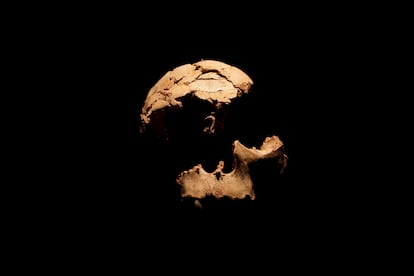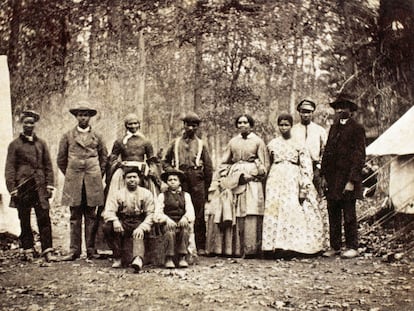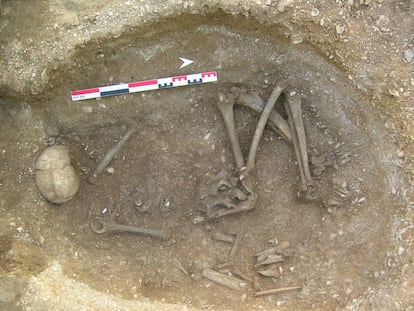Extreme cold killed the first settlers in the Iberian Peninsula
The glaciation that took place 1.1 million years ago drastically lowered the temperature, which caused a barren environment. This is according to a new study published by ‘Science’

The first humans in Europe experienced a climate change that could have killed them. The ancestors of modern humans were already living in the Italian and Iberian peninsulas between 1.2 and 1.4 million years ago, as remains found in the archaeological site of Atapuerca, in the north of Spain, can attest. But their possible descendants — the Homo antecessor, also found at the site near the city of Burgos — took nearly half-a-million years to emerge. This raises the question: what happened in between?
Today, a paleoclimatic study has discovered an extreme cold event that possibly changed the climate and the environment all those years ago. It was so severe that it may have been what caused the human species to disappear from European soil.
The climate of the Iberian Peninsula, when the ancestors of modern humans arrived, was Mediterranean. “More Mediterranean than now,” clarifies Juan Luis Arsuaga, co-director of the Atapuerca site. Those hominins didn’t yet know about fire, nor did they need to master the technology of treating animal skins to combat the cold. It’s also believed that the fat balance in the bodies of these early settlers also wasn’t the most suitable for a cold climate. Hence, they must have had a rough time when, 1.1 million years ago, a new ice age advanced — one that completely covered the British Isles, the English Channel and almost all of Europe with ice. As would happen later with the Neanderthals (and with us sapiens), Southern Europe must have been the last refuge. But, according to a study now published in the journal Science, that glaciation had such an extreme cold peak that it modified the climate and environment in the surrounding areas. According to the article’s authors, the cold should have wiped out those first Europeans.
The clues in this story of climate extermination begin in the Tagus River and end at the bottom of the ocean. About 120 miles off the coast of Portugal, southwest of Lisbon, is a location known to scientists as U1385. Several sediment cores have been extracted from the seabed, which have written the climatic history of the last 2.5 million years. In its different layers, there are fossils of foraminifera — marine organisms with a shell — that are key to studying the past. The composition of these seashells can explain what the water was like when they were formed. For example, they’ve served to show how the asteroid or meteorite that wiped out the dinosaurs long ago acidified the sea. In this recent publication, researchers reveal that, during this particular glaciation, the waters of the Atlantic slowed down, with a decline in the so-called Atlantic meridional overturning circulation (AMOC) — a set of currents that modifies the climate of the Northern Hemisphere.
The most obvious consequence of this ocean slowdown, due to the contribution of Arctic freshwater and the advance of ice, was the drop in sea temperatures. How much exactly it dropped is detailed by Joan Grimalt, a researcher at the Institute for Environmental Diagnosis and Water Studies (IDAEA-CSIC) and co-author of the paper in Science. “The average temperature of the water at this latitude is 19º Celsius at our time. During that event, it went down to 5 or 6 degrees Celsius, when, in other glaciations, it went down to 10 degrees Celsius,” Grimalt notes. There’s no means to measure the inland temperature. But, “while it’s not mathematical, in general, a drop of one degree at sea corresponds to a drop of three degrees on land,” Grimalt adds. From a hot Mediterranean climate, “in the Iberian Peninsula, we went to one like that of Siberia. And that, in addition to the extreme cold, translates into less availability of fruits and animals to feed on,” the scientist concludes.
Shells, pollen and supercomputing
In the nuclei of that seabed, there is also pollen from terrestrial plants. This confirms what Grimalt said. The first author of the study is Vasiliki Margari, from University College London. Margari is an expert in palynology — the part of botany dedicated to the study of pollen and spores. She explains how the vegetable grains got there: it was the Tagus River, not the wind, that carried them to the sea. From the analysis of this pollen, Margari deduces that the vegetation changed radically: the glaciation, which lasted thousands of years, caused a decline in trees and the advance of steppe plants. The presence of steppe pollen on the seabed increased by 45%. “During the extreme cold event of 1.1 million years ago, [there was] a great expansion of steppe plants; temperate trees and heaths almost disappeared,” Margari explains. This extreme event lasted 4,000 years.
Previously, it hadn’t been possible to connect this climatic cooling with the destiny of the first settlers of Europe. This has now finally been done with the help of supercomputing. Axel Timmermann — a researcher at the National University of Pusan (South Korea) and co-author of the study — explains it in a video distributed to the media: “To quantify the [cold’s] impact on human occupation, we ran a comprehensive climate model and [examined a] habitat model human in our Aleph supercomputer. The results of these computational experiments are clear: early humans in Europe could not have survived this extreme glaciation and the associated large drop in net primary productivity and vegetation.”
The results of this work would fit with the absence of human remains or stone tools in Europe in the hundreds of thousands of years after that period of climate change. The thesis is that, only a long time later, the Homo antecessor found in Atapuerca was part of a new wave of human ancestors who recolonized Europe. They already had a mastery of fire and knew how to take advantage of animal skins. As they were better adapted to the cold, they could survive.
However, Juan Luis Arsuaga — one of the most knowledgeable paleoanthropologists when it comes to this part of human evolution — questions the main conclusions of this work. “Marine witnesses are of great importance, but terrestrial records are needed. We didn’t see arctic flora and fauna until the last ice age (which started about 110,000 years ago and ended about 10,000 years ago). The Iberian Peninsula never froze, nor was there permafrost until this glaciation,” he affirms.
“The fact that there’s no record of human fossils and their stone utensils in the period between the first known settlers of Iberia and Homo antecessor doesn’t necessarily mean that there was no one living in Europe in that intervening period. It may be that we just haven’t found evidence of their presence yet.”
So then, what happened in that period after the extreme cold event? “We don’t know,” Arsuaga admits.
Sign up for our weekly newsletter to get more English-language news coverage from EL PAÍS USA Edition
Tu suscripción se está usando en otro dispositivo
¿Quieres añadir otro usuario a tu suscripción?
Si continúas leyendo en este dispositivo, no se podrá leer en el otro.
FlechaTu suscripción se está usando en otro dispositivo y solo puedes acceder a EL PAÍS desde un dispositivo a la vez.
Si quieres compartir tu cuenta, cambia tu suscripción a la modalidad Premium, así podrás añadir otro usuario. Cada uno accederá con su propia cuenta de email, lo que os permitirá personalizar vuestra experiencia en EL PAÍS.
¿Tienes una suscripción de empresa? Accede aquí para contratar más cuentas.
En el caso de no saber quién está usando tu cuenta, te recomendamos cambiar tu contraseña aquí.
Si decides continuar compartiendo tu cuenta, este mensaje se mostrará en tu dispositivo y en el de la otra persona que está usando tu cuenta de forma indefinida, afectando a tu experiencia de lectura. Puedes consultar aquí los términos y condiciones de la suscripción digital.
More information
Archived In
Últimas noticias
Welcome to the post-religion era: The idea of Christianity as the absolute truth has become obsolete
‘I thought you would like it’: The risky sexual practice popularized by TV shows and TikTok
The digitalization of tourism: ‘They promise experiences and gave us the worst possible one’
Mexican peso defies uncertainty with forecasts of a new period of stability in 2026
Most viewed
- Sinaloa Cartel war is taking its toll on Los Chapitos
- Oona Chaplin: ‘I told James Cameron that I was living in a treehouse and starting a permaculture project with a friend’
- Reinhard Genzel, Nobel laureate in physics: ‘One-minute videos will never give you the truth’
- Why the price of coffee has skyrocketed: from Brazilian plantations to specialty coffee houses
- Silver prices are going crazy: This is what’s fueling the rally











































